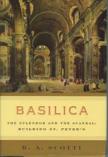A Very Long Story
Although it may be hard to imagine a volume on the construction of St. Peter’s Basilica as a beach book, R. A. Scotti has produced an account gripping enough to be one. The subtitle, The Splendor and the Scandal hints at its focus. This is not a dry account for the architectural journals, but what would have appeared in Reformation-era tabloids, had they existed.
That does not mean that Scotti is dishing fluff. She places the construction of St. Peter’s within the vast sweep of church history. Her portraits of popes, financiers, architects and artists are so vivid that connections between art, money, theology and revolution come alive in ways rare in church history texts.
The construction is an epic, covering 161 years and 30 papacies. Along the way it sparked the Protestant Reformation, led to the sack of Rome and was instrumental in the city’s recovery. Legendary figures of art and architecture feuded and schemed over its creation. Plans changed constantly; parts were built, torn down and rebuilt. And from the beginning, historic preservationists protested the slow destruction of the original basilica built by the Emperor Constantine. Scotti writes:
There were numerous builders, many contradictory plans and disharmonious junctures. Yet entering St. Peter’s the visitor experiences unity as solid as dogma. There is no suggestion that the Basilica was a work in progress for more than two centuries. From a confusion of sacred and secular, from a clash of genius and a stew of ironies, an extraordinary feat of architecture and engineering emerged.
The sacrifice was huge. The Renaissance popes hocked the family jewels in the name of art, begged, borrowed and splintered the Christian Church to build the Basilica. The details changed, but the ideal remained constantto construct a metaphor in stone for the leap of faith that is at the heart of the gospel of Christ.
A novelist and previous chronicler of the great hurricane of 1938, Scotti writes that she has been fascinated by the basilica since she was a 19-year-old visitor in the time of Pope Paul VI. She profiles highly complex characters, from Michelangelowho appears mentally troubled but truly devoutto certain popes whose example still makes Catholics cringe. She treats them more charitably than they often treated each other.
If our own motives are often unclear, the motives of a pope or a painter five hundred years ago are at best conjecture. I have tried not to ascribe or assume motive and suggest it only when I can quote someone’s own words. Since even these can be misleading, proceed with a generous mind, she tells the reader.
The feuding between the initial architect, Donato Bramante, the paranoid Michelangelo and the upstart artist Raphael was extraordinary. Michelangelo was commissioned to paint the Sistine Chapel as something of a consolation prize after Bramante’s basilica displaced a papal tomb that Michelanglo had believed would be his masterpiece. Ultimately it was Michelangelo who would triumph, by virtue of living far longer than any other player in the drama.
One of the most memorable characters to emerge from the author’s pen is Pope Julius II (1503-1513), a flawed but dedicated and administratively brilliant pope who commissioned St. Peter’s. After Julius came the Medicis. Scotti describes how their self-indulgent governance led to the Protestant Reformation as they abused the faith and the faithful to raise money for the basilica.
To a young Augustinian monk in Saxony, the trafficking in indulgences to finance an enormous new Basilica was the tipping point. Martin Luther had been profoundly shaken by the decadent behavior he saw when be visited Rome in the summer of 1511.... From the perspective of a penurious friar, a Medici prince did not need the pennies of the working poor to finance an opulent new church, Scotti writes.
When the cardinals belatedly realized the grave danger in which the Medici decadence placed the church, they elected a pope known to me previously only as a footnote to the papacy of Pope John Paul II. Adrian VI was an ascetic monk from the Netherlands and the last non-Italian to hold the seat for 455 years. But the Romans chafed under his imposition of holy simplicity and, when he died after less than two years, brought the Medicis back to power.
In due time, Protestants from Germany marched over the Alps and sacked Rome, leaving it in ruins. But its revival would ultimately come with the completion of the basilica.
To augment her story, Scotti provides a timeline showing the popes and architects alongside stages of construction and key world events. There are helpful diagrams of the basilica, with a glossary of terms, and fascinating drawings showing how an array of architects conceived it with multiple domes or bell towers as soaring and slender as minarets.
In 2005 I spent two months working in and around the Vatican, and felt that I had had my fill of St. Peter’s and all that surrounds it. This book made me long to return, to look at the basilica, its surroundings and some of Rome’s ancient villas with newly awakened eyes. Anyone who plans a trip to Rome would do well to take Basilica on the plane. It will keep you engrossed.
This article also appeared in print, under the headline “A Very Long Story,” in the October 2, 2006, issue.








